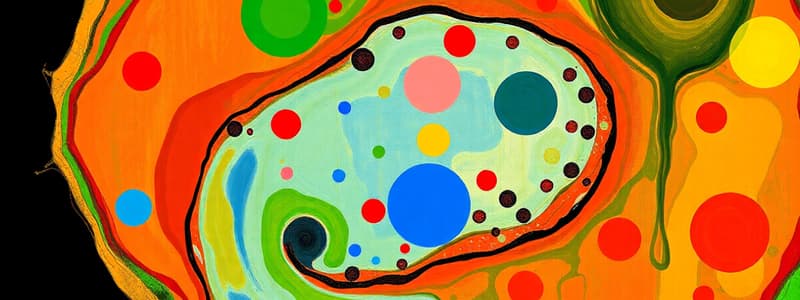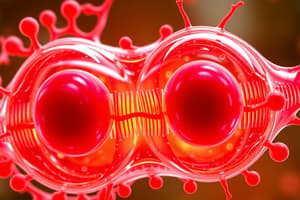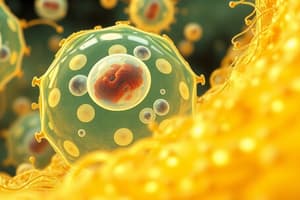Podcast
Questions and Answers
What is the primary function of microfilaments in a cell?
What is the primary function of microfilaments in a cell?
- Regulate exchange of materials
- Anchor organelles like the nucleus
- Segregate chromosomes during cell division
- Aid in cell movement and support cell structure (correct)
All cell types in the human body possess membranous organelles.
All cell types in the human body possess membranous organelles.
False (B)
What term describes the structure of the plasma membrane?
What term describes the structure of the plasma membrane?
Fluid mosaic
The __________ is the basic unit of life and the human body.
The __________ is the basic unit of life and the human body.
Match the structures to their functions:
Match the structures to their functions:
What is the main function of mitochondria?
What is the main function of mitochondria?
Mitochondria contain their own DNA and replicate independently of the nuclear genome.
Mitochondria contain their own DNA and replicate independently of the nuclear genome.
What is the term for the process which produces ATP in the presence of oxygen?
What is the term for the process which produces ATP in the presence of oxygen?
The inner mitochondrial membrane is extensively folded to form cristae__.
The inner mitochondrial membrane is extensively folded to form cristae__.
Which phase of the cell cycle involves DNA replication?
Which phase of the cell cycle involves DNA replication?
Meiosis results in two identical daughter cells.
Meiosis results in two identical daughter cells.
What type of cell division occurs in somatic cells?
What type of cell division occurs in somatic cells?
During prophase, chromatin condenses into chromosomes___.
During prophase, chromatin condenses into chromosomes___.
What is a key characteristic of telomeres?
What is a key characteristic of telomeres?
Cytokinesis follows mitosis in cell division.
Cytokinesis follows mitosis in cell division.
Match the following phases of mitosis with their descriptions:
Match the following phases of mitosis with their descriptions:
What is the role of DNA polymerase during DNA replication?
What is the role of DNA polymerase during DNA replication?
The two halves of a replicated chromosome are called sister chromatids.
The two halves of a replicated chromosome are called sister chromatids.
Which term describes the sequence of events in somatic cell division?
Which term describes the sequence of events in somatic cell division?
Aerobic cellular respiration can occur without oxygen.
Aerobic cellular respiration can occur without oxygen.
How does water move through aquaporins?
How does water move through aquaporins?
Isotonic solutions cause no net movement of water across the cell membrane.
Isotonic solutions cause no net movement of water across the cell membrane.
What term describes solutions with a relatively lower solute concentration than the cell?
What term describes solutions with a relatively lower solute concentration than the cell?
In a __________ solution, a red blood cell would crenate.
In a __________ solution, a red blood cell would crenate.
Match the following types of solutions with their effects on cells:
Match the following types of solutions with their effects on cells:
Why are intravenous (IV) fluids usually isotonic to blood?
Why are intravenous (IV) fluids usually isotonic to blood?
If you are severely dehydrated, which type of solution would be best to drink?
If you are severely dehydrated, which type of solution would be best to drink?
Aquaporins are channel proteins that facilitate the movement of solutes across the cell membrane.
Aquaporins are channel proteins that facilitate the movement of solutes across the cell membrane.
What structure is responsible for organizing microtubules in animal cells?
What structure is responsible for organizing microtubules in animal cells?
Cilia are long structures that propel cells while flagella are short and assist in movement.
Cilia are long structures that propel cells while flagella are short and assist in movement.
What are the small holes in the nuclear envelope called that allow materials to exit?
What are the small holes in the nuclear envelope called that allow materials to exit?
The dense region in the nucleus responsible for making ribosomal subunits is called the __________.
The dense region in the nucleus responsible for making ribosomal subunits is called the __________.
Match the organelles with their primary functions:
Match the organelles with their primary functions:
What is the function of ribosomes?
What is the function of ribosomes?
The rough endoplasmic reticulum is involved in the synthesis of proteins destined for the cytoplasm.
The rough endoplasmic reticulum is involved in the synthesis of proteins destined for the cytoplasm.
Where do ribosomes assemble their subunits?
Where do ribosomes assemble their subunits?
The __________ is all of the DNA in an organism.
The __________ is all of the DNA in an organism.
Which organelle is involved in detoxifying alcohols and metabolizing fatty acids?
Which organelle is involved in detoxifying alcohols and metabolizing fatty acids?
Tay-Sachs disease results from dysfunctional peroxisomes.
Tay-Sachs disease results from dysfunctional peroxisomes.
What do tRNA molecules carry that matches the mRNA sequence?
What do tRNA molecules carry that matches the mRNA sequence?
The ________ modifies and packages proteins for export from the cell.
The ________ modifies and packages proteins for export from the cell.
What is the pH of the interior of lysosomes?
What is the pH of the interior of lysosomes?
Match the diseases to their associated organelle dysfunction:
Match the diseases to their associated organelle dysfunction:
What is the primary function of the sodium-potassium (Na+-K+) pump in animal cells?
What is the primary function of the sodium-potassium (Na+-K+) pump in animal cells?
Secondary active transport requires direct use of ATP to move solutes across the membrane.
Secondary active transport requires direct use of ATP to move solutes across the membrane.
What is the process called when a cell engulfs large particles or cells?
What is the process called when a cell engulfs large particles or cells?
Water moves through a semi-permeable membrane during _________.
Water moves through a semi-permeable membrane during _________.
Match the following transport processes with their descriptions:
Match the following transport processes with their descriptions:
Which type of active transporter moves substances against their concentration gradients using energy from ATP hydrolysis?
Which type of active transporter moves substances against their concentration gradients using energy from ATP hydrolysis?
Cyanide inhibits active transport by blocking vesicular transport only.
Cyanide inhibits active transport by blocking vesicular transport only.
What is the chemical formula of water?
What is the chemical formula of water?
The process of moving solutes when one solute flows down its concentration gradient and helps move another solute up its gradient is called ________.
The process of moving solutes when one solute flows down its concentration gradient and helps move another solute up its gradient is called ________.
Match the following membrane transport processes with their specific characteristics:
Match the following membrane transport processes with their specific characteristics:
Which component makes up the majority of biological membranes?
Which component makes up the majority of biological membranes?
Membrane fluidity is essential for biological function.
Membrane fluidity is essential for biological function.
What is the role of cholesterol in biological membranes?
What is the role of cholesterol in biological membranes?
Membrane is permeable to __________ molecules like O2 and CO2.
Membrane is permeable to __________ molecules like O2 and CO2.
Match the membrane proteins with their functions:
Match the membrane proteins with their functions:
Which statement best describes the fluid mosaic model?
Which statement best describes the fluid mosaic model?
Saturated fatty acids lead to a more fluid membrane than unsaturated fatty acids.
Saturated fatty acids lead to a more fluid membrane than unsaturated fatty acids.
What is simple diffusion?
What is simple diffusion?
The __________ of the lipid bilayer allows for the lateral movement of proteins and lipids.
The __________ of the lipid bilayer allows for the lateral movement of proteins and lipids.
What happens to membrane fluidity at higher temperatures?
What happens to membrane fluidity at higher temperatures?
Facilitated diffusion requires energy input to transport solutes across membranes.
Facilitated diffusion requires energy input to transport solutes across membranes.
What is meant by 'selective permeability' of membranes?
What is meant by 'selective permeability' of membranes?
The __________ gradient is important in the process of facilitated diffusion.
The __________ gradient is important in the process of facilitated diffusion.
What type of proteins are likely to serve as cell identity markers?
What type of proteins are likely to serve as cell identity markers?
Flashcards are hidden until you start studying
Study Notes
Cell Structure and Function
- Cells are the basic unit of life and are highly diverse with ~200 different cell types in the human body.
- Each cell has a unique structure that reflects its function.
- Organelles are small subunits within cells that perform specific functions.
- Membranous organelles are surrounded by a membrane, while non-membranous organelles are not.
- Only eukaryotic cells possess membranous organelles.
Plasma Membrane
- The plasma membrane is a flexible barrier that surrounds the cell, separating the internal and external environments.
- It regulates the exchange of materials between the cell and its surroundings.
- The plasma membrane is also involved in cell communication.
Cytoplasm
- The cytoplasm is the region between the plasma membrane and the nucleus.
- It contains a jelly-like fluid called cytosol and various organelles.
- The cytosol provides an aqueous environment for cellular chemical reactions.
Cytoskeleton
- The cytoskeleton is a network of protein filaments that shapes, stabilizes, and moves cells and their internal structures.
Microfilaments
- Made of actin and myosin.
- Aid in cell movement, support cell structure, and form microvilli.
Intermediate Filaments
- Made of various protein subunits.
- Provide tensile strength and anchor organelles like the nucleus.
Microtubules
- Made of tubulin.
- Dynamic structures that rapidly assemble and disassemble.
- Segregate chromosomes during cell division.
- Form cilia and flagella, aiding in cellular movement.
Centrosome
- The microtubule-organizing center in animal cells.
- Contains short microtubules called centrioles.
- Plays a crucial role in the formation of the mitotic spindle during mitosis.
Cilia and Flagella
- Made of microtubules.
- Cilia are short bundles of microtubules that move like oars, found in the respiratory tract and oviduct.
- Flagella are long bundles of microtubules that whip through fluids, found in human sperm.
Nucleus
- The nucleus is a membranous organelle that contains DNA.
- It is surrounded by a nuclear envelope with nuclear pores which allow the passage of RNA and ribosomal subunits.
- The nucleolus is a dense region where ribosomal subunits are made.
DNA Packaging
- DNA must be tightly packaged for efficient storage and movement during cell division.
- Uncoiled DNA is called chromatin, where genes are accessible for transcription.
- Tightly wound DNA forms chromosomes, where genes are inactive.
- The genome comprises all the DNA in an organism.
Ribosomes
- Ribosomes are composed of ribosomal RNA (rRNA) and protein.
- Assembles in the cytoplasm as a large and small subunit.
- Some ribosomes attach to the rough endoplasmic reticulum (rER).
- Ribosomes translate mRNA into proteins.
Central Dogma of Biology
- DNA sequences called genes encode information to make proteins.
- Genes are transcribed into mRNA.
- mRNA is translated by ribosomes into proteins.
Endoplasmic Reticulum (ER)
- A network of membranes involved in protein translation, modification, and lipid synthesis.
Rough ER (rER)
- Dotted with ribosomes.
- Synthesizes proteins destined for organelles.
- Exports membranes to other organelles.
Smooth ER (sER)
- Synthesizes lipids, including fatty acids and steroids.
- Inactivates drugs in liver cells.
- Participates in carbohydrate metabolism.
- Stores calcium ions.
Golgi Complex
- Modifies, sorts, finishes, and sends proteins to their destinations.
- Two distinct faces:
- Entry face receives proteins from the rER.
- Exit face exports cellular proteins.
- Proteins are modified within the Golgi and packaged into vesicles for export.
Lysosomes
- Spherical, membrane-bound sacs containing digestive enzymes.
- Maintain an acidic pH (pH 5).
- Break down and recycle cellular molecules.
- Defects in lysosomes can lead to lysosomal storage disorders, such as Tay-Sachs disease.
Peroxisomes
- Spherical, membrane-bound sacs with a crystalline core.
- Contain oxidases that metabolize fatty acids and detoxify alcohol.
- Contain catalase, which breaks down hydrogen peroxide.
Proteasomes
- Large cellular machines that break large polypeptides into smaller peptides.
- Other peptidases further break the peptides into amino acids.
- Dysfunction of proteasomes can contribute to diseases like Parkinson's or Alzheimer's.
Mitochondria
- Bounded by two membranes: outer and inner mitochondrial membranes.
- The space between the membranes is called the intermembrane space.
- The inner membrane is folded into cristae.
- The inner membrane encloses the mitochondrial matrix.
- Aerobic cellular respiration occurs primarily in the mitochondria, converting glucose into ATP.
- Mitochondria are maternally inherited and contain their own DNA.
- Mitochondrial dysfunction can trigger cell death (apoptosis).
Somatic Cell Division
- Somatic cells divide by mitosis and cytokinesis.
- The cell cycle consists of interphase and M phase.
Interphase
- A period of cell growth with three stages:
- G1: Cell growth and preparation for DNA replication.
- S phase: DNA replication.
- G2: Replication of cytoplasmic components.
M phase (Mitosis)
- Division of nuclear components.
- Four stages:
- Prophase: Dissolution of the nuclear envelope and condensation of chromatin into chromosomes.
- Metaphase: Alignment of chromosomes at the equatorial plate and attachment of the mitotic spindle.
- Anaphase: Separation of chromosomes to opposite poles of the cell by the mitotic spindle.
- Telophase: Partitioning of the two components into two forming daughter cells.
Cytokinesis
- Division of the rest of the cellular components.
Chromosome Anatomy
- An unreplicated chromosome is a single structure.
- A replicated chromosome is composed of two sister chromatids joined at the centromere.
- The kinetochore is a protein complex around the centromere that serves as the attachment site for the mitotic spindle.
Telomeres
- DNA sequences at the ends of chromosomes that protect against degradation.
- Telomere length decreases with age.
- Cancer cells have overactive telomerase, which elongates telomeres, allowing for rapid cell division.
Reproductive Cell Division (Meiosis)
- Meiosis is the division of reproductive cells into gametes, which are haploid cells.
- Meiosis consists of two rounds of division.
Meiosis I
- The cell divides replicated chromosomes into daughter cells.
- Crossing over occurs, exchanging genetic information between homologous chromosomes.
- Results in two daughter cells with haploid sets of chromosomes.
Meiosis II
- Separates sister chromatids into two separate gametes.
- Results in four non-identical daughter cells (gametes) with haploid chromosomes.
Membrane Structure and Function
- The plasma membrane is a fluid mosaic, with lipids and proteins floating freely in a bilayer.
- The lipid bilayer is composed of phospholipids, cholesterol, and glycolipids.
Membrane Fluidity
- Essential for membrane function.
- Regulated by:
- Saturation of fatty acid tails: Saturated fatty acids lead to less fluidity.
- Cholesterol: Influences membrane fluidity by increasing space between lipids and restricting movement.
- Temperature: Higher temperatures increase fluidity.
Selective Permeability
- Membranes are selectively permeable, allowing only certain substances to cross.
- Nonpolar molecules can readily diffuse across the lipid bilayer.
- Polar molecules require transport proteins to cross.
Membrane Proteins
- Integral membrane proteins are anchored to the hydrophobic core of the lipid bilayer.
- Peripheral membrane proteins are bound to the membrane by electrostatic interactions.
- Glycoproteins are membrane proteins with attached saccharides.
- Membrane proteins serve various functions:
- Receptors: Bind specific molecules and trigger intracellular signaling.
- Enzymes: Catalyze chemical reactions.
- Linker proteins: Connect cells and facilitate movement.
- Cell identity markers: Help distinguish cell types.
Membrane Transport
- Solutes can cross membranes through various mechanisms.
Simple Diffusion
- Passive transport of nonpolar solutes down their concentration gradient.
- No metabolic energy required.
Facilitated Diffusion
- Passive transport of charged or polar solutes down their concentration gradient with the help of transport proteins (ion channels or carrier proteins).
- No metabolic energy required.
Active Transport
- Movement of solutes against their concentration gradient.
- Requires metabolic energy (usually ATP).
Electrochemical Gradient
- The combined influence of the concentration gradient and electrical gradient of a charged substance.
- Substances move from an area of high concentration to low concentration and from an area of one charge to an area of opposite charge.
Active Transport
- Moves solutes against their concentration gradients across membranes.
- Requires energy, often from ATP hydrolysis.
- Sodium-potassium (Na+-K+) pump:
- Keeps Na+ concentration higher outside the cell.
- Keeps K+ concentration higher inside the cell.
- A carrier protein that changes shape using energy from ATP hydrolysis.
- Primary active transporters:
- Move solutes up their concentration gradients using ATP hydrolysis.
- Secondary active transporters:
- Use electrochemical gradients set up by primary active transporters for energy.
- Move two solutes simultaneously.
- One solute moves down its concentration gradient, releasing free energy that moves the other solute up its gradient.
- Symporters: Both solutes move in the same direction.
- Antiporters: Solutes move in opposite directions.
- Cyanide inhibits ATP production in the mitochondrion, impacting all active transport.
Vesicular Transport
- An active transport process that uses membrane sacs called vesicles to move products between organelles.
- Endocytosis: Movement into cells via vesicles.
- Exocytosis: Movement of substances out of cells.
- Transcytosis: Movement of substances through cells by endocytosis followed by exocytosis.
- Receptor-mediated endocytosis: Imports specific molecules into cells.
- Phagocytosis: "Eating" of molecules or invaders by phagocytic cells.
- Substances/cells are engulfed and internalized into a vesicle.
- Vesicle fuses with lysosome, and contents are digested.
- Important for immune cells (e.g., macrophages, neutrophils).
- Pinocytosis: Cell "drinking" of dissolved solutes.
- Also called bulk-phase endocytosis.
- Large volumes of molecules imported into a vesicle, then fuse with lysosome.
- Important for immune cells that surveil the body for invaders.
Osmosis
- The movement of water from low solute concentration to high solute concentration across a semi-permeable membrane.
- Water can move across the lipid bilayer, but it is very inefficient.
- Aquaporins: Channel proteins that facilitate the efficient diffusion of water across biological membranes.
- Cells behave differently in different solutions based on tonicity, which is determined by the osmolarity of the solution.
Tonicity
- Hypertonic solutions: Have a higher solute concentration than inside the cell.
- Water moves out of the cell.
- Cell shrinks.
- Hypotonic solutions: Have a lower solute concentration than inside the cell.
- Water moves into the cell.
- Cell swells.
- Isotonic solutions: Have the same solute concentration as inside the cell.
- No net water movement.
Cell Function
- Cells are organized by organelles.
- Membranous organelles compartmentalize cell function within membranes/membrane folds.
- Nonmembranous organelles perform specific functions in the cytoplasm.
- Somatic cells divide by mitosis, producing two identical daughter cells.
- Reproductive cells divide by meiosis, producing four nonidentical gametes.
Studying That Suits You
Use AI to generate personalized quizzes and flashcards to suit your learning preferences.




